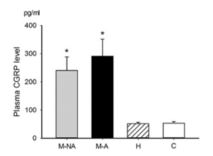Context
Migraine is a disorder characterized by recurring pulsating headaches with increased sensitivity to light, sound and head movement. It is one of the leading causes of disability.
Few studies have characterized the effect of anti-migraine medications on children. Since most young children cannot accurately describe their symptoms, finding biomarkers that can guide the choice of migraine treatment is crucial.
Calcitonin gene-related peptide (CGRP) has been shown to be a biomarker of migraine in adults. CGRP causes dilatation of both peripheral and cerebral blood vessels. Baseline plasma CGRP levels are significantly higher in migraine adult patients than in healthy controls. Additionally, during a migraine attack, the plasma CGRP levels of both adult and pediatric patients increase and strongly correlate with headache intensity.
In this study, the scientists explore whether CGRP could be a biomarker helping stratification of migrainous children, by studying the relation between plasma CGRP levels and the responses to anti-migraine therapies.
Materials
- 120 pediatric subjects were recruited, who never took anti- migraine drugs, including 68 patients with migraine (M), 30 with non-migraine headache (H), and 22 non-headache controls (C).
- Blood (3 ml) sampled from the cubital vein of each patient was put into a 5 ml Lavender tube (BD vacutainerTM, Becton Dickenson, Plymouth, UK).
- Plasma samples were prepared by centrifugation (2,000 rpm for 15 min) of the whole blood and then stored at −80°C.
- Plasma CGRP levels were measured using CGRP (human) ELISA kit (Cat No. A05481, Bertin Bioreagent, France). The person who conducted the CGRP measurement was blinded to the identity, attack status, and treatment of the study patients.
- Short-term therapeutic response to anti-migraine drugs was measured for at least 2 weeks after the start of therapy. Responders were defined with >50% headache reduction.
Results
Mean plasma CGRP level is found higher in migraineurs compared to non-migraine headache patients and to non- headache patients. This higher plasma CGRP is observed during migraine attack as well as between attacks.
Topiramate responders had higher plasma CGRP levels than non-responders (437 ± 131 pg/ml, n = 14 vs. 67 ± 19 pg/ml,
n = 6, p = 0.021). Survival curves of plasma CGRP levels also showed those with higher CGRP levels responded better to topiramate

Plasma CGRP levels in different groups.
The mean plasma CGRP levels in the migraineurs either during (group M-A) or between (group M-NA) attacks were higher than the non-migraine headache patients (group H) (p
= 0.006 and 0.018, respectively) and non-headache controls (group C) (p = 0.016 and 0.045, respectively). The p-value among groups, analyzed by ANOVA test (p = 0.001), followed by post-hoc Tukey HSD. *p < 0.05
Comparison of plasma CGRP levels between responder and non-responder to anti- migraine drugs. Data are mean ± SE with the n number in parentheses. The p-value between responder and non-responder groups, analyzed by Mann-Whitney test * p<0.05.


